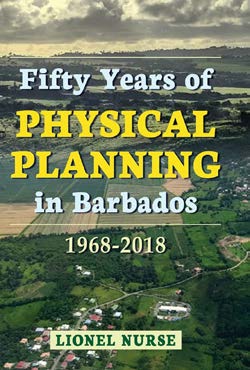-1968 To 2018
By Lionel Nurse
Over the past five years following my retirement from the Public Service I have been in the process of writing a book.
The manuscript entitled Fifty Years Of Physical Planning In Barbados chronicles the need for an evolution of the system of Town and Country Planning on the island, the elements of planning, the strengths and weaknesses in the present practices and recommendations to rectify the current systemic and operational shortcomings thus allowing for a more efficient, effective and transparent system.

Starting from its genesis in the Barbados Public Health Act of 1908 when subdivision development was first controlled, the book traces the development of the system through the various pieces of enabling legislation ending with tne proclamation of The Town and Country Planning Act of 1968 and the establishment of the planning office in 1959.
The work dissects and analyses the Barbados planning system including the rationale for it, the key elements of practice, planning methodology, and the strengths and weaknesses of the present arrangements.
The book culminates with recommendations for the improvement of the system through changes to the legislation, practice and processes, including a more structured approach to incorporating environmental impact assessment into the decision-making.
An important aspect of the work has been the documenting of a data base of planning cases which were adjudicated in the local courts and the implications for the practice of physical planning on the island, of the fifteen cases for which there are written judgements.
In one case, the judgement led to the complete revamping of the way in which applications called in by the Minister under section 18 of the Planning Act which at present involves agricultural land of two acres or more, and beachfront lands are processed and by whom.
This has had the effect of causing a significant change to the way these types of applications were processed over the last thirty years and new administrative arrangements within the planning structure.
I am hoping that this work will stimulate thinking on the functioning of the land use and physical planning system on the island and contribute to its improvement.
The formal planning system was established on the island fifty years ago but in recent years its efficiency as a regulatory system has been questioned as well as its transparency and integrity .
Indeed the planning office has been specifically mentioned as one on the major regulatory agencies on the island which have negatively impacted the national development effort and has been targeted by the new government as a mission critical element of its national management strategy for major reform as part of an International Monetary Fund assisted program.
Indeed, a new Planning and Development Act has already passed the parliamentary process and is now awaiting proclamation.
The book ends with comments on the new planning legislation which I formally submitted for consideration as part of the public participation process for the revised Act.
This work will help to put these changes into context as the new legislation and processes are rolled out.
I believe that I am in a position to do this effectively by virtue of my training and experience in this area and having functioned as the country’s Chief Town Planner for 14 years.
This work can be of use to practising planners in both the government and private sector, students, lawyers and persons in related disciplines and professions such as architecture and engineering and land surveying.
In particular there are five planning schools existing within CARICOM whose students and faculty should find it of direct interest and usefulness. https://www.amazon.com/Fifty-Years- Physical-Planning-Barbados/dp/B099BN2QVP




